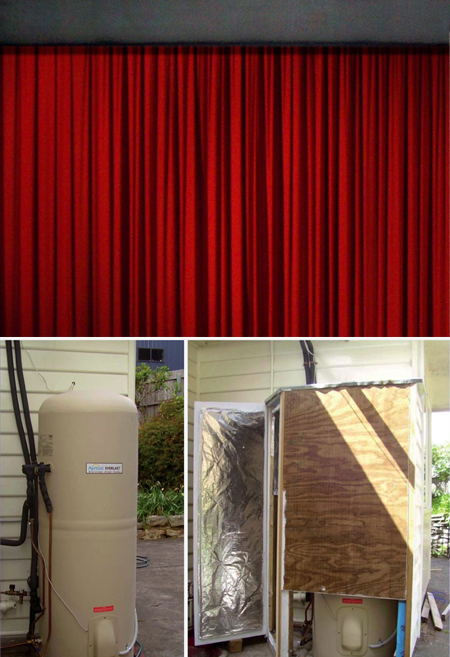Tasmania’s home energy programs are a tiny first step, but they’re real value for money. [26 October 2011 | Peter Boyer]

Small things can make a lot of difference, such as pelmets above curtains and good insulation around a hot water storage heater. PHOTOS CHRIS HARRIES
Climate change is a topic for grand statements on big stages, heavy with portent for all of humanity. Those who talk about it, like yours truly, used to assume that people would stop and listen when the talking point is the future of the planet.
They might have listened once, but time and repetition have blunted the message. Climate has to compete with other things demanding our attention, usually with a dollar sign attached. Things like dealing with the rent or the mortgage, the school fees or the dental treatment.
Or the power bill. For about four years the cost of electricity around Australia — and around the world — has been rising at a rate far above the incremental increases of times past, to pay for the cost of replacing old poles and wires and developing new metering and billing systems.
As we all know, the resulting price rise of about 10 per cent a year is an unexpected, unpleasant financial burden. For poorer households it’s been crippling.
Something has to give. People who can’t afford to pay the bills or to change their space or water heating — say by installing gas or wood heaters, or solar hot water — have had to live with less power. In some cases they’ve switched off altogether.
The typical Tasmanian home of my childhood was a weatherboard shell with iron roof above, wooden floor below and plaster walls and ceilings. This was all that lay between us kids and the frosty air outside. If insulation was discussed then, we hadn’t heard of it.
We managed because our land supplied firewood and because our parents, brought up without electricity, rationed use of radiators and lights. Power wasn’t cheap, but it was a predictable year-on-year cost item. Going without it was never an option — that would be going against progress.
So here we are now, rationing our electricity. This is where progress has got us to.
Actually there is progress, though some mightn’t see it. As a community we Tasmanians now know a lot more about the true cost of energy, learned from years of struggling with the debt incurred in building our hydro infrastructure — an investment in renewable energy that in a carbon-priced economy will soon earn us a dividend.
No longer taking electricity prices for granted, Tasmanians are now looking for ways to use less in their homes. By happy coincidence, a cash-strapped State government has recognised the cost-effectiveness of a policy to encourage exactly that, while also making a dent in carbon emissions.
Five months ago in its climate “action plan”, the Giddings government identified three main avenues for reducing emissions: more renewable energy generation, sequestering carbon through better forestry and farming practices, and reducing energy use in buildings.
That plan was announced amid growing concerns about the government’s financial situation. Since then it’s turned into a full-blown crisis, putting into question the viability of every spending measure including the already limited provisions of the “action plan”.
The crisis has cast a shadow over the Renewable Energy Industry Development Board’s advice that Tasmania should phase out all fossil energy by 2020 to enable it to export renewable power. The target is achievable, yet even with the promise of national carbon pricing rewards this government, desperate to save money, may baulk at investing the capital needed to reach it.
The government has barely started on its land-use strategies, including accounting for forest carbon, but whatever verifiable emissions reduction such measures can deliver, this won’t happen soon. Which leaves lower energy use in buildings as the most likely source of savings.
This is a winner whichever way you look at it. Given the high and rising cost of electricity, using less of it will save us money, while also making a 100 per cent renewable target (and prospects for exporting hydro and wind power to the mainland) that much more achievable. Exporting such power will bring top dollar into the state.
Improving your home’s energy efficiency can be surprisingly cheap. Measures like installing a water-efficient shower head (costing about $10), putting pelmets above curtains and installing ceiling insulation, each costing a few hundred dollars, will pay for themselves in a very short time.
Bringing together her portfolio responsibilities of climate change and human services, Cassy O’Connor is seeking to apply limited financial resources precisely where they will have most effect, in the oldest Housing Tasmania homes where poor insulation and high power costs are adding to the burdens of already-stressed tenants.
A $900,000 program to employ consultants to help public housing tenants save power by the most cost-effective way possible has gone out to tender. Covering both energy-efficient appliances and building insulation, the program is to be rolled out over six months from next March.
The success of this initial phase of a $6 million program will see it extended over the next two years to other low-income households, both public and private.
Housing Tasmania tenants are also encouraged to become “energy champions”, requiring them to commit to energy-saving measures in their homes while spreading the word about the gains from doing so. Each of the 100 “champions” will get a solar hot water system on the roof.
In the scheme of things, this is pretty small. The examples provided by the Housing Tasmania champions need to be rolled out in homes across the state and across all income levels to make a dent in our emissions. It’s a first step. We just have to keep walking.
• For ideas about saving energy around the home, go to the Sustainable Living Expo, Princes Wharf, Hobart, on the weekend of November 5-6.
